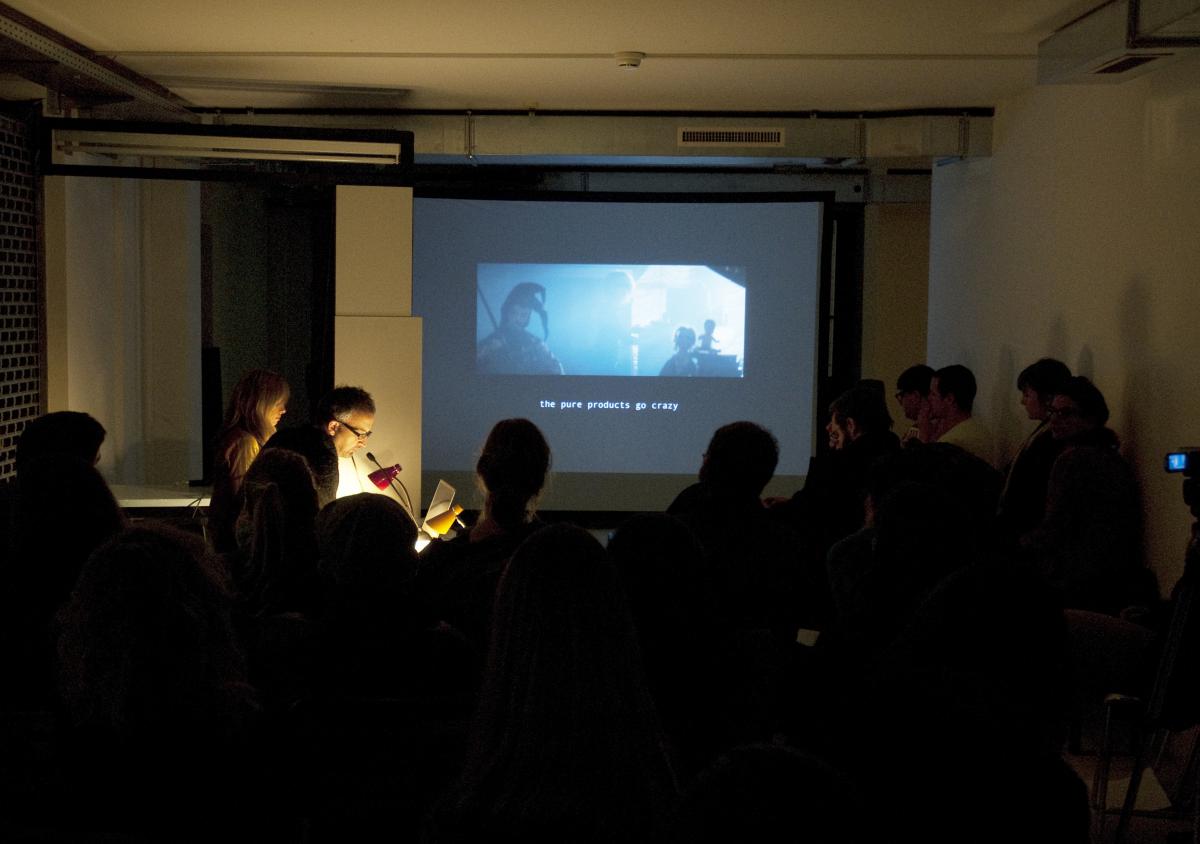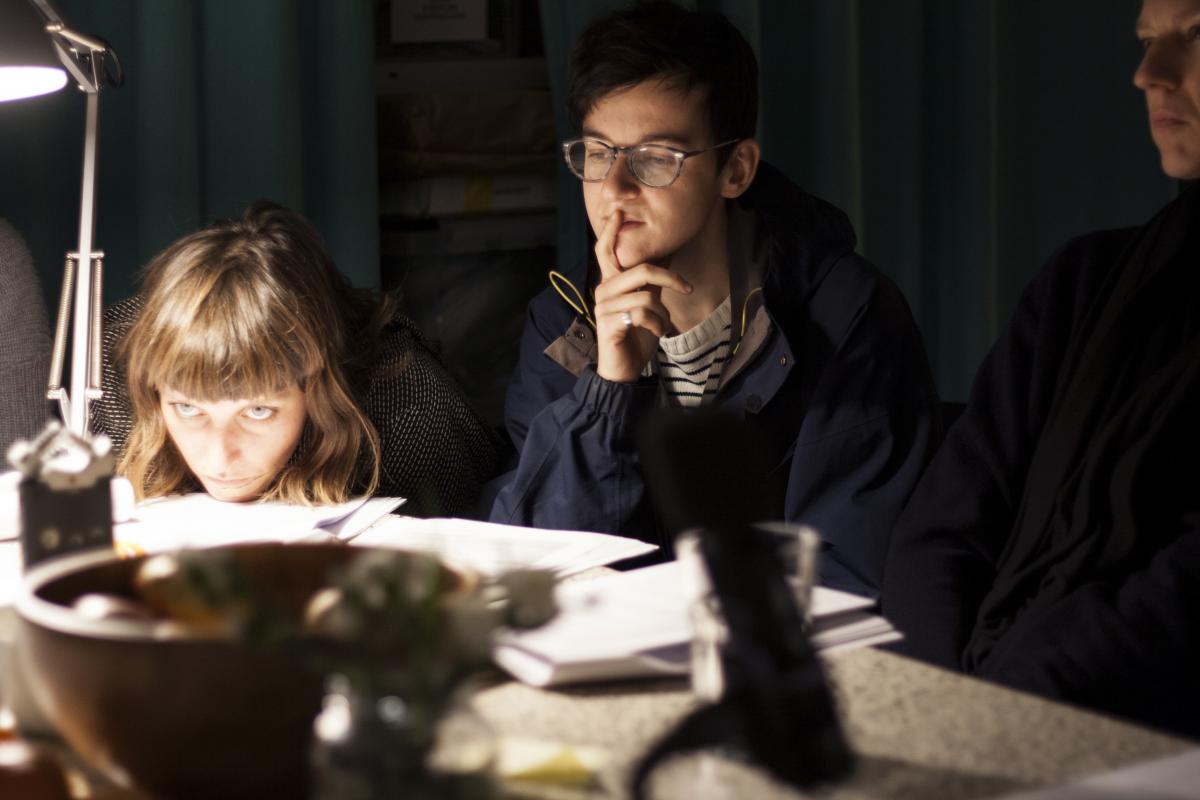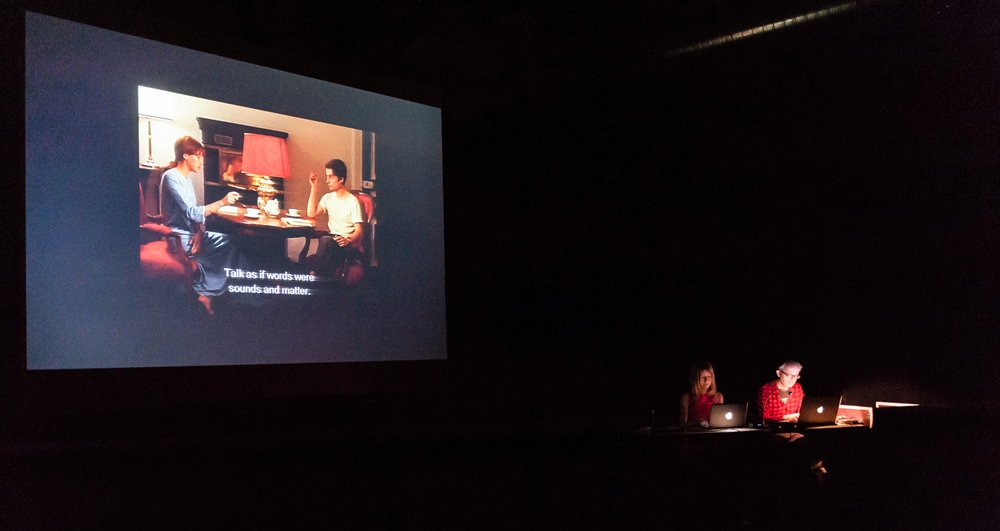Interview with Silvia Maglioni & Graeme Thomson
by Erik Bullot
Érik Bullot. Would you define your project around Félix Guattari’s script Un amour d'UIQ as a performative film?
Silvia Maglioni :
Since our encounter with Un amour d'UIQ and Guattari's other unmade cinema projects in the archives in 2010, we were immediately confronted with the question of how to publish such liminal, unstable documents, structures that wanted to be other structures, to use Pasolini's expression, how to avoid the passage from the archive boxes to book form becoming simply a short journey from one sarcophagus to another. Among the various strategies we came up with while structuring the book and writing an introductory visual essay was to use performative presentations as a research tool. This allowed us to test out our hypotheses within a fabulatory, sometimes even fictional frame, and to reactivate from the very beginning an archive that had been buried for some twenty-five years. The first of these, 'UIQ: A Space Oddity', which took place at Bétonsalon quite a while before we found a publisher, was mainly focused on somewhat hallucinatory connections that we drew between 1980s sci-fi movies and the 1970s Italian Autonomia movement, and possibly because of this approach a real pathway opened up, leading us to the discovery of an overlooked box containing a script for a film on free radio, written around the time of the Autonomia uprisings of 1977, and an outline for a film project that Guattari had written with Robert Kramer in 1979 around two Italian fugitives escaping to France... 'UIQ: A Space Oddity' became a mutable platform for us, each time incorporating different images and sounds, inhabiting a shadow zone which at times could resemble a live-film (in a gallery in Zurich, during the Q&A, some people were convinced it was a "film"). The last time we performed it, at MACBA in Barcelona, we felt its form was becoming rigidified, too much like a "proper performance": it was the right time to exit (just like Ziggy...).
Other elements of our project around UIQ flirt with what we might call the performative dimension (the seeances, the soundwork, parts of our own film In Search of UIQ). But if we go back to Austin's reflections on performative utterances and verbs in particular (verbs that accomplish an act through their very enunciation), with a perverse twist of logic we could also say that what we've been doing all the way through is exactly the opposite. The whole focus of the project has been the idea of non-realisation, undoing or unmaking, and the crafting of a series of variations around this notion. So, to go back to Guattari's unmade screenplay Un amour d'UIQ, we could say that what we have been trying to do is to unaccomplish the film through its very enunciation.
Graeme Thomson : Yes, and the question of unmaking equally concerns the ways that the unmade film continually tends to withdraw from, or elude, its various manifestations, and therefore from form in general, in the same manner that UIQ itself, in Guattari's script, never arrives at a stable form or locus of self. Of course one could say that the performative in some way embodies this type of instability. But for me the word has always had connotations of efficiency or efficacy not surprisingly it's one of the most frequently used terms in the liturgy of neo-liberalism so I would prefer not to use it. In some sense, what we look for is more of the order of inefficiency, a kind of stepping aside from form or embodiment, the careful preparation of partially empty spaces, spaces of non-inscription, of disappointment even, that might compel the viewer to look further or to look elsewhere. Our vocation is vacation. But we're also interested in the contaminative effect of these zones.

É.B. Could an installation or a display be a film for you?
G.T. For a long time now, we've been interested in the notion of "exploded" cinema, and the films we've made up to this point have all, to a greater or lesser degree, harboured installation forms in potentia. That said, we have little interest in the procedure, quite widespread in the art world, of simply installing a film in a gallery. For us the installation of a film necessary involves a formal and even material mutation, a process of virtualization that reverses the actualized film into the problematic field of its making, and, we could also say, of its unmaking or undoing. For installations, we operate a bit like a "distribution" company in the sense that we redistribute the film by dismantling it and dispersing its component parts. And installation is also a question of the redistribution of time. One of the most powerful things about cinema is the sense in which a film can kidnap the viewer and remove them from their temporal habitus. We are generally carried or transported by a film (even the most deconstructed, non-linear films will have this effect), while an installation allows us to drift and our attention to wander. It has no real hold over us. That's because the weight of time is distributed differently. With a film, if it's a good one, all of time is in the film, even that of the person watching it. In the case of an installation, the viewers and the work generally keep their time at a distance from one another, even if there is some overlap. Yet, if we continue to be interested in installation it is partly because of the challenge it presents in trying to overcome this distance. For us it's often a question of spatial montage and of transforming the interstitial spaces between elements into cracks in time, letting in a draught of elsewhere wind that will gently, or violently, loosen the viewer's hold on their own time.
S.M. But your question was partly addressing the reversal of this, the process through which an installation or a mixed-media environment can become, or aspires to be perceived as, a film. There would be a lot to say on the subject so for the moment I'll continue to dwell in the infinitely small dimension of the Infra-quark Universe. The most recent manifestation of UIQ took the form of a soundwork, comprised of about 75 voices that we edited together, mixed with music and sound textures that Graeme composed, from recordings made in various countries on the occasion of a series of what we called seeances. For these, we invited small groups of envisionaries to gather around passages of Guattari's screenplay and to share their own visions of the unmade film or of UIQ itself, and its effects on them.
Rather than a cinematic production that would reduce the indeterminate matter of UIQ to a specific set of representations, exploitable as commercial product, the film gradually came into being through its unworking as a living process of variations. In simultaneously inhabiting the roles of reader, writer, director, actor, medium, seer, listener and viewer, the participants forming these temporary communities (vaguely mirroring the community who make contact with UIQ) could explore and expand the territories of the film both from within and without, multiplying its narrative and affective folds, blurring the borders between actualisation and virtual projection. Which also meant that the UIQ effect could be there in the room with and between us. People would start to feel the space and each other’s presence differently, their tone of voice would change, something in the atmosphere shifted, though it’s hard to say exactly what.
To go back to the question of time, our temporal perception also changed in these sessions (which lasted up to 18 hours) and became like zones of autonomous temporality. As we went on with the seeances, we began to realise we didn’t need to rely so heavily on Gauttari's script. Sometimes just the suggestion of a situation or scene was enough to set imaginations going. Plus there were aspects of the script some people didn’t find particularly fruitful or that they wanted to take in another direction.
In the soundwork, these voices, spaces and visions co-exist, resonate, feed off and build upon each other. In the beginning, the idea was to ‘recompose’ Guattari’s film through glimpses of what had been evoked or speculated upon by the more than seventy envisionaries, but during the mixing process where we began to spatialise the voices, we and our mixing engineer, Thomas Fourel, noticed another ‘film’ emerging in parallel to UIQ: the portrait of this scattered community coalescing and coming into some kind of being of its own.
The soundwork was installed at The Showroom in London in February-March 2015, for our solo show it took forever getting ready to exist: UIQ (the unmaking of), with a series of other works around Guattari's missing cinema. But can we say that this was a sort of invisible film? And, if so, at what point did it start to become one? During the seeances, which for us were a kind of shoot without a movie camera, a documentary that would be screened only once - at the time of its making? At the vernissage, or during the exhibition, when visitors might themselves be contaminated by the unseen visions of UIQ they were hearing? Or after leaving the gallery, when they might start to wonder or discuss with others who hadn’t been to the exhibition what UIQ would look or whether it ate, breathed, slept?
G.T. Another thing worth mentioning here is that the soundwork was designed to function simultaneously as the centrepiece and accompaniment of the show, its presumed centrality was continually being undone by other pieces (or components of pieces) we had made over the five years of research.

É.B. Could you describe your relationship and practice towards archives?
G.T. I suppose our approach to archives has been heavily influenced by the literature of the fantastic, Poe, Borges and Kafka especially. There is the question of the space of the archive itself as a somewhat sinister labyrinth of buried secrets and pockets of dark matter, a space of fiction and possible delirium for the researcher, but also a kind of limbo.
This leads us to the second important consideration for us: the nature of the archive documents we are drawn to, often marginal, derisory or unachieved fragments hovering on the edges of a writer’s official oeuvre, trapped somewhere between being and non-being, and usually troubling the prevailing image we have of the author. In our first feature film Facs of Life, the video archive of Deleuze’s seminar at Vincennes, shot by Marielle Burkhalter and some of her comrades in 1975-76, served primarily as a pretext to locate some of the students who appear in the images, though it was also an image of pedagogy, and of a pedagogical possibility (informal, somewhat ragged, polycorporeal) that had been in some way suppressed. In the case of Guattari’s sci-fi film and his filmmaking ambitions in general, what emerged were the lineaments of another possible “career” for a schizoanalyst whose thinking already traversed so many different fields of enquiry, one that held the promise of slightly unhinging the models of production and desire that mainstream cinema represented.
S.M.
Both film projects that Graeme mentioned - around what we could call Deleuze and Guattari's lost cinema - took many years to develop, and went through different forms and articulations. To a certain extent, we can say that they are still in progress. While working on Facs of Life we came up with a word that best described our approach to the archive, inarchivé - which seemed to us a more useful concept than Derrida’s notion of the ‘anarchivic.’
More recently, we've been experimenting with archives in a more rapid, punctual manner adopting methods and tools that will hopefully develop into a collective platform. In a series of short films that we call tube-tracts, we've been drawing upon situationist strategies of détournement and the artisanal methodology of the ciné-tracts pioneered by Godard, Marker, Resnais and others during May 1968 to hypothesize a deconstructivist, poetic use for contemporary viral media, using material mainly from the vast oceanic archive of youtube. The idea initially came as a provisional and partial response to what was for us a burning question surrounding the evolution and diffusion of technologies of the image. Given the tools and material resources we now have at our disposal, how can we rethink montage to harness and mobilize the virtual reserves of political and affective singularity and duration at work in images that are often produced, or uploaded, for immediate consumption and circulation, and generally destined to oblivion?

G.T. For the film-performance underwritten by shadows still, meanwhile, we were thinking about the performativity of subtitles as something potentially autonomous from the film dialogues they normally serve to translate. The procedure we have created is quite simple: we've selected around 300 subtitled frames (from the 700 we had pre-selected) from different films, and put them in a sequence so that each subtitle will link to the one that follows. During the event, Silvia re-enacts the role of a kind of projectionist figure, launching the stills, while I am at my laptop accompanying the images "underwritten by shadows still" with a live improvised electronic score. Most of the films we watch are subtitled and we like to closely supervise the subtitling of our own films, so for us subtitles are in a way an actual component of the image, rather than just a functional addition to it. For instance, for the brief time it occupies the screen a subtitle is a static presence in relation to the film’s movement. It's also something of a paradox, being both under and over, at the bottom of the screen but overlaid on the image. And being text, it opens up a potential "book" dimension of cinema. Sometimes subtitles begin to function like a kind of commentary on the image or they give visible shape to the dimension of what Pasolini and Rohmer refer to as a free indirect mode of discourse. We wanted to treat the subtitle text as something akin to the neutral or the middle voice Blanchot speaks about, to think about how we could create a single discourse (or how a latent speech might emerge) from a sequence of stills culled from hundreds of different films. So rather than performing a film, we have this meta-film perform and speak in our place (in the last person, as Beckett would have it, or perhaps even the lost person) and see what it has to say to us. For our residence at Labos, we're planning to continue to experiment with what we call "dark matter cinema", and with these infra-forms...
---------------------
Photos :
UIQ: A Space Oddity, Le Foyer Zurich, photo courtesy of Petra Koehle
UIQ Seeance at CASCO - Office for Art, Design and Theory, Utrecht, photo courtesy of Casco
A hard case speaking softly / underwritten by shadows still / A soft touch playing hard to get, Les Laboratoires d'Aubervilliers, 2015, photo courtesy Ouidade Soussi-Chiadmi

